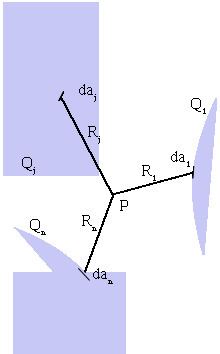 | ||
In electrostatics, the coefficients of potential determine the relationship between the charge and electrostatic potential (electrical potential), which is purely geometric:
Contents
where Qi is the surface charge on conductor i. The coefficients of potential are the coefficients pij. φi should be correctly read as the potential on the i-th conductor, and hence "
or more formally
Note that:
- pij = pji, by symmetry, and
- pij is not dependent on the charge,
The physical content of the symmetry is as follows:
if a charge Q on conductor j brings conductor i to a potential φ, then the same charge placed on i would bring j to the same potential φ.In general, the coefficients is used when describing system of conductors, such as in the capacitor.
Theory
Given the electrical potential on a conductor surface Si (the equipotential surface or the point P chosen on surface i) contained in a system of conductors j = 1, 2, ..., n:
where Rji = |ri - rj|, i.e. the distance from the area-element daj to a particular point ri on conductor i. σj is not, in general, uniformly distributed across the surface. Let us introduce the factor fj that describes how the actual charge density differs from the average and itself on a position on the surface of the j-th conductor:
or
Then,
can be written in the form
i.e.
Example
In this example, we employ the method of coefficients of potential to determine the capacitance on a two-conductor system.
For a two-conductor system, the system of linear equations is
On a capacitor, the charge on the two conductors is equal and opposite: Q = Q1 = -Q2. Therefore,
and
Hence,
Related coefficients
Note that the array of linear equations
can be inverted to
where the cij with i = j are called the coefficients of capacity and the cij with i ≠ j are called the coefficients of electrostatic induction.
The capacitance of the above two-conductor example system can be expressed in terms of the cij as
(the system of conductors can be shown to have similar symmetry cij = cji.)
